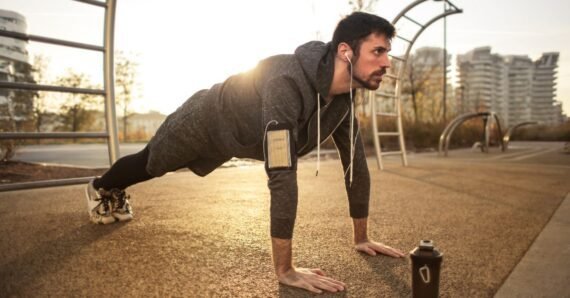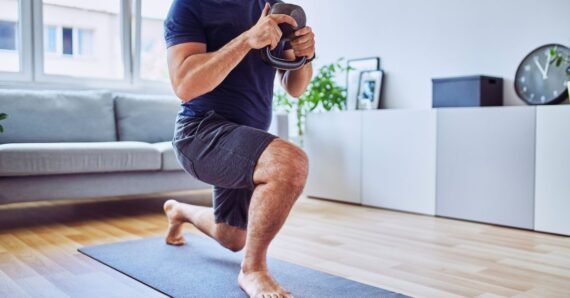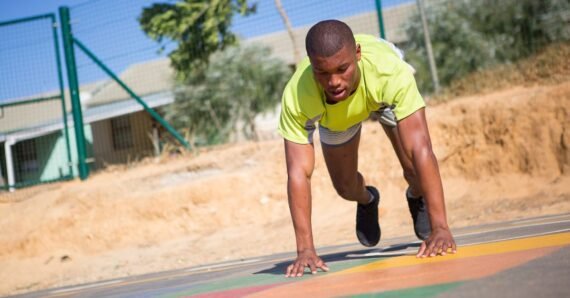20 Different Types of Exercises – A Comprehensive Guide to Fitness Variety
Exercising can be a key to maintaining a healthy lifestyle, and the variety of workouts available makes fitness accessible to people of all skill levels. With 20 different types of exercises to explore, individuals can find routines that fit their preferences and pace.
These workouts are designed to enhance strength, flexibility, and overall health without requiring a gym membership or expensive equipment.
Incorporating a range of movements targeting various muscle groups, the selection of exercises ensures a comprehensive approach to fitness. This variety not only helps to improve physical prowess but also keeps motivation high by offering engaging and refreshing routines.
Whether at home or in the park, these exercises serve as building blocks for a robust workout regimen.
Different Types of Exercises
lets explore
1) Push-Ups
Push-ups are a fundamental exercise suitable for those starting a fitness journey or seasoned athletes aiming to boost their strength. They work multiple muscle groups, including the chest, arms, and core, providing a full-body workout. Here are three variations graded from simple to more challenging:
- Standard Push-Up: Begin in a plank position with hands shoulder-width apart. Lower the body toward the ground, then push up to the starting position. Ensure the back is straight and the core is engaged throughout the move.
- Incline Push-Up: Place hands on a raised surface, such as a bench. Lower the chest to the edge of the surface and press back up. This variation reduces the weight on the arms, making it easier.
- Decline Push-Up: With feet elevated on a raised surface and hands on the ground, perform a push-up. This version increases the difficulty by adding more body weight to the arms and shoulders.
Incorporating these exercises into a routine can strengthen and sculpt the upper body. Individuals can progress at their own pace, gradually moving to more demanding variations as their fitness levels improve.

By executing these actions, one ensures a comprehensive workout for the upper body. For anyone seeking to diversify their exercise regimen further, exploring additional push-up forms can introduce new challenges and keep the fitness experiência engaging.
2) Squats
Squats are an essential component of fitness routines aimed at strengthening the lower body. This exercise targets the thighs, hips, buttocks, quads, and hamstrings and strengthens the core.
Beginners often start with bodyweight squats, standing tall with feet hip-width apart and lowering the body as if sitting back in a chair while keeping the chest up. This fundamental movement is crucial for daily activities and promotes balance and mobility.
For those seeking variety, there are numerous adaptations of squats. The narrow stance squat, for example, places more emphasis on the quadriceps. Alternatively, a wider stance with toes pointed outward can engage the inner thighs and glutes more intensely. Incorporating equipment like barbells or dumbbells can raise the difficulty level and further enhance muscle growth and endurance.
A notable variation highlighted by experts involves placing hands behind the head, pulling the elbows back, and squatting while maintaining an elevated chest, which is beneficial for improving posture.
Maintaining proper form is vital in all variations to maximize effectiveness and minimize injury risk. As muscles adapt, increasing the squat’s complexity can continue to deliver fitness gains, making squats a versatile and valuable part of any workout regimen.
3) Lunges
Lunges are a fundamental exercise for anyone aiming to enhance their lower body strength and coordination. They primarily target the quadriceps, but they also engage the glutes, hamstrings, and calves. This exercise can be done anywhere, making it a flexible option for various workouts.
Types of Lunges:
- The Basic Lunge: Step forward with one foot and lower your hips until both knees are bent at a 90-degree angle.
- The Lateral Lunge: This involves stepping to the side instead of forward, which targets the inner thigh muscles.
- The Reverse Lunge: By stepping backwards instead of forward, you can reduce stress on the knees.
Incorporating lunges into your routine is beneficial because they mimic everyday movements, such as walking and climbing stairs. For beginner athletes, the Chair Lunge is a great starting point, providing stability and support. More advanced individuals may try the Plyometric Jump Lunge to add a cardiovascular challenge.
Each variety serves a unique purpose. The Curtsy Lunge, for example, focuses on the outer thigh and glute areas—meanwhile, the Dumbbell Lunge increases the overall difficulty by adding weight resistance.
To keep the body balanced, it is important to perform lunges on both sides. Consistent practice ensures improvement in lower body strength and muscular symmetry. As with any exercise, proper form is critical to preventing injury and maximizing benefits.

4) Plank
Planks are a core-strengthening exercise that offers numerous benefits. They engage multiple muscle groups simultaneously, making them an efficient workout choice. The primary muscles targeted during a plank are the rectus abdominis, obliques, forearms, erector spinae, and upper body.
Different Types of Planks:
- O forearm plank is a popular variation that is considered less stressful on the wrists.
- Straight-arm planks provide a solid foundation and are slightly more challenging for the wrist.
- Side planks focus primarily on the obliques and can be performed on either forearm.
- Variations such as plank with leg lifts e plank with arm reach add extra difficulty.
When performing any plank, maintaining proper form is crucial. This includes keeping a straight line from head to heels, engaging the abs, and being careful not to let the hips sway. It’s beneficial to start with shorter durations and gradually increase as the body becomes more accustomed to the exercise.
For beginners, adding plank variations to a workout routine can be done through a progression of difficulty. It’s advisable to start with the basics and work up to more advanced positions over Time.
Regularly incorporating planks into a fitness regimen helps to enhance core stability and strength. This foundational exercise is not only adaptable to different fitness levels but also serves as an excellent base for more complex movements.
5) Burpees
Burpees are a dynamic exercise that targets multiple muscle groups. They involve a combination of a squat, push-up, and jump, often repeated in quick succession for a set number of reps or periods. These movements together make burpees an effective full-body workout that improves strength, endurance, and coordination.
Key steps in performing a burpee:
- Start in a standing position.
- Lower into a squat with hands on the floor.
- Kick your feet back to a plank position.
- Perform a push-up.
- Return to the squat position.
- Explode upwards into a jump.
Burpees can be modified to suit various fitness levels. For instance, the push-up segment might be omitted for beginners, or jumps can be intensified to increase difficulty. Incorporating burpees into your routine contributes to better cardiovascular fitness while also engaging the chest, arms, core, legs, and shoulders.
People often have questions about the effectiveness of burpees and how many they should do to see results. As a high-intensity full-body exercise, they can effectively burn calories and build muscle when incorporated into regular workouts.
However, the exact number of recommended burpees can vary based on individual fitness levels and metas. It’s essential to perform them with proper form to maximize benefits and prevent injury.
For those seeking to diversify their burpee workouts, numerous variations can keep the exercise challenging and engaging:
- Single-leg burpees
- Burpee with side-jump
- Burpee to box-jump
- Burpee with tuck-jump
- Burpee with mountain climbers
Frequent practice and increasing intensity or volume gradually over time can lead to significant improvements in overall fitness and physical condition.

6) Mountain Climbers
Mountain climbers are a dynamic exercise that mixes cardiovascular training with muscular endurance and agility. To perform this exercise, start in a high plank position. Your hands should be below your shoulders, and your body should be in a straight line from head to heels.
Step-by-step guide:
- Engage your core: Keeping your abs tight is crucial for stability.
- Lift knees: Alternate, bringing each knee towards your chest rapidly as if running in place.
This exercise has variations to keep the routine fresh and challenge different muscle groups:
- Cross-Body: Bring your right knee towards your left elbow and vice versa.
- Wide Knee: Aim your knees to the outer side of your elbows.
- Spider: Bring your knee to the outside of the same elbow.
Integrating mountain climbers into your workout can enhance the following:
- Cardio endurance: It gets your heart rate up.
- Core strength: It targets your abdominal muscles.
- Upper body stability: Your arms, shoulders, and chest work to stabilize the position.
For novices, slow down the pace. More advanced individuals can increase speed or add a twist to the move. As with any exercise, mountain climbers should be performed in the proper form to prevent injury and maximize effectiveness. Remember to breathe consistently throughout the exercise.
7) Tricep Dips
Tricep dips are a key exercise for strengthening the upper body, particularly the triceps muscles on the back of your upper arms. They’re simple to perform and require minimal equipment. Typically, you can use parallel bars or the edge of a stable chair to execute this compound movement, which also engages your chest and shoulders.
How to Perform Tricep Dips:
- Setup:
- Begin by sitting on the edge of a stable chair or bench.
- Grip the edge next to your hips with your fingers pointing down.
- Position:
- Extend your legs out with heels pressing firmly into the ground.
- Keep your back close to the chair as you slide off, supporting your weight with your arms.
- Execution:
- Lower your body by bending your elbows to about a 90-degree angle.
- Press back up to the starting position, straightening your arms.
For beginners or those who need assistance, variations such as bent-knee dips or assisted dip machines can make the exercise more manageable. More experienced individuals might try advanced variations like weighted dips to increase the challenge. Remember to maintain proper form to avoid injury and maximize the benefits of this powerful upper-body exercise.
8) Bicep Curls
Bicep curls are a fundamental exercise aimed at enhancing arm strength and muscle. They involve lifting weights with an underhand grip and curling the arms upward. This activity targets the biceps brachii, a two-headed muscle on the upper arm.
Performing bicep curls requires one to stand with feet shoulder-width apart, a weight in each hand, with arms extended downward. The movement begins by bending the elbows and curling the weights toward the shoulders, then lowering them back down with control.
Variations of bicep curls can add diversity to workouts:
- Hammer curls involve holding the weights with a neutral grip and working both the biceps and forearms.
- Preacher curls are done using a preacher bench to isolate the biceps by eliminating any momentum.
- Concentration curls are performed seated, with the elbow rested against the inner thigh, focusing tension on the biceps.
- Cable curls use a cable machine, providing constant tension through the motion.
- Reverse curls flip the grip to palms down, targeting the biceps and forearm extensors.
Each variation should be practised with good form to prevent injury and ensure maximum benefit. They can be grouped into a routine performed two to three times weekly, with repetitions ranging from 8 to 15 for muscle growth and strength.
9) Overhead Shoulder Press
Strength training is crucial for upper body fitness, and the overhead shoulder press is a fundamental move for developing solid shoulders. This exercise primarily targets the deltoid muscles but also works the triceps and upper back.
Steps to Perform the Overhead Shoulder Press:
- Position Yourself: Stand with your feet shoulder-width apart and grip the barbell just wider than your shoulders.
- Lift Off: Raise the barbell to your shoulders and position it near your collarbone.
- Press Up: Extend your arms, pushing the barbell upward until your elbows are locked and the bar is over your head.
- Lower with Control: Slowly bring the bar back to the starting position at your shoulders.
When performing the overhead shoulder press, ensure proper form to prevent injuries. Individuals with shoulder issues should approach this exercise with caution.
Common Variations Include:
- Dumbbell Shoulder Press: Use dumbbells instead of a barbell for an alternate challenge.
- Push Press: Incorporate your legs slightly to help drive the weight up.
- Arnold Press: Start with palms facing you and rotate outward as you lift.
This exercise can improve posture, enhance athletic performance, and build overall upper body strength. Remember to start with an appropriate weight and increase gradually to avoid strain.
10) Bench Press
The bench press is a classic exercise known to target the chest, shoulders, and triceps.
1. It starts with lying on a bench, gripping the barbell with hands just wider than shoulder-width. As one lowers the bar to chest level, elbows should make a 90-degree angle.
2. Then, pressing upwards, fully extend the arms without locking the elbows.
Key points:
- Feet Position: Plant feet firmly on the ground.
- Hand Placement: Begin with hands slightly wider than the shoulders.
- Breathing: Inhale on the way down, exhale, pushing up.
Apart from the conventional flat bench press, several variations enhance different parts of the chest and arms. 3. The incline bench press shifts focus to the upper chest. 4. The decline variation targets the lower chest.
Incorporating bench presses into workout routines can vastly improve upper body strength. 5. For those looking to progress, adjusting grip width or adding weights incrementally is crucial. It’s essential to prioritize form over heaviness to avoid injury.
Consistency in performing the bench press will lead to noticeable gains in strength and muscle size. 6. Adding it as a staple of chest days can offer balanced upper body development.
Safety is paramount, so utilizing a spotter during heavier sets is highly recommended. They can assist in case of muscle failure or accidental slips, ensuring a safer and more effective exercise session.
11) Deadlifts
Deadlifts are a powerhouse move for strengthening muscles from head to toe. They are like a utility player in baseball: versatile and practical. With different variations of the exercise, one can target specific muscle groups and keep the routine fresh. Here are a few deadlift forms that can spice up a workout:
- Conventional Deadlift: This classic deadlift with feet shoulder-width apart engages the entire posterior chain, which includes the hamstrings, glutes, and lower back.
- Sumo Deadlift: With a wider stance and toes pointed out, this type focuses more on the quadriceps and inner thighs.
- Romanian Deadlift: This variant involves a slight bend in the knees and focuses on the hamstrings and glutes, requiring one to push the hips back as they lower the weight.
- Trap Bar Deadlift: Uses a hexagonal bar that changes the grip, placing less stress on the lower back and allowing for a more upright trunk angle.
Each type has its benefits and can be chosen based on the muscles one wants to emphasize or the level of impact on the joints. Deadlifts aren’t just for those who want to lift heavy; they’re also crucial for improving grip strength and overall athletic performance. For beginners, it’s wise to start with lower weights and focus on proper form to prevent injury.
12) Pull-Ups
Pull-ups are a fundamental upper-body exercise that involves lifting the body from a hanging position until the chin clears the bar. They primarily work the back muscles like the latissimus dorsi but also engage the biceps, forearms, and shoulders. This exercise can be modified in various ways to suit different skill levels or to target specific muscles more intensely.
Different Types of Pull-Up Variations:
- Standard Pull-Up: Grasp the bar with an overhand grip and lift your body until the chin passes the bar.
- Chin-Up: Using an underhand grip, this variation puts more emphasis on the biceps.
- Neutral-Grip Pull-Up: Palms facing each other. This style is often gentler on the shoulders.
- Commando Pull-Up: Grip the bar with both hands next to each other and pull the body up, rotating to each side.
- Wide-Grip Pull-Up: Expands the grip beyond shoulder width, intensifying the work on the lats.
- Close-Grip Pull-Up: Hands closer than shoulder width to target the lower lats more.
- Behind-the-Neck Pull-Up: Pulling up with the bar behind the head is a challenging variant and should be done with caution.
- Weighted Pull-Up: Add extra weight via a belt, vest, or holding a dumbbell between the feet.
- One-Arm Pull-Up: A highly advanced variant requiring significant strength and technique.
- L-Sit Pull-Up: Combining core activation by keeping the legs straight out in front while pulling up.
Performing pull-ups correctly requires a tight core throughout the movement and controlled descent to avoid injury and maximize strength gains. Beginners may start with assisted variations, such as using resistance bands or a pull-up machine, while more experienced exercisers can increase difficulty with the advanced versions. Always prioritize proper form over the number of repetitions.
13) Russian Twists
Russian Twists are a dynamic exercise that strengthens the core, involving a twist of the torso. They are often incorporated into fitness routines to enhance core strength and the stability of the shoulders and hips. This exercise specifically targets the oblique muscles on the sides of the abdomen.
Performing Russian Twists begins with sitting on a mat with knees bent and feet flat. Leaning slightly back, one should lift their feet slightly off the ground, balancing on their sit bones. With hands joined together in front of the chest or holding a weight for added difficulty, they twist their torso to the left and then to the right, engaging the core throughout.
Critical Points in Doing Russian Twists:
- Ensure Proper Form: Keep the back straight and avoid slouching to prevent strain.
- Controlled Movements: Twists should be performed with control, avoiding any jerky motions.
- Breathing: Breathe out with each twist to maintain rhythm and core engagement.
Variations of this exercise allow for different levels of difficulty. These can include holding a weight plate or medicine ball while twisting or performing the twist in a more reclined position to increase the challenge for the core muscles.
14) Leg Raises
Leg raises are a core strengthening exercise that targets the lower abdominal muscles. Beginners can start with bent knee leg raises, placing their feet flat and hands by their sides. To perform, one lies flat and presses the lower back into the floor while raising the legs.
Steps to Perform a Leg Raise:
- Lie on your back with your hands at your sides.
- Keep your legs straight and lift them to the ceiling until your body forms a 90-degree angle.
- Pause at the top, then lower your legs back down without letting them touch the floor.
This exercise enhances stability in the core and can aid in improving lower body strength. Individuals may begin with 2-3 sets of 10-12 repetitions, ensuring they move slowly to maintain form.
For those seeking to advance their workout, variations include hanging leg raises or adding weight for increased resistance. It’s crucial to maintain proper form to maximize benefits and minimize the risk of injury.
By incorporating leg raises into a fitness routine, one can work towards a stronger core, which is crucial for overall stability and performance in various physical activities. Consistency and proper technique are vital for seeing progress with this exercise.
15) Jumping Jacks
Jumping jacks are a classic, full-body exercise recognized for increasing cardiovascular endurance and toning muscles. They are simple, effective, and can be done just about anywhere. This exercise involves jumping to a position with the legs spread wide and the hands going overhead, then returning to a position with the feet together and the arms at the sides.
Here are a few variations of the classic jumping jack to mix up your routine:
- Squat Jack: Start with feet together, jump into a squat with legs apart, and return to the starting position. This version works your glutes and legs more intensely.
- Plank Jack: Begin in a plank position; jump your feet out to the sides and back again. It’s a great way to incorporate your core and lower body.
- Cross Jack: Cross your arms and legs in front of you, then jump back into the standard jack position. This adds a new level of coordination and activates your inner thighs.
Practising jumping jacks can benefit cardiovascular health, increase agility and coordination, and are easily modified to suit various fitness levels. They are suitable for warm-ups or as part of a high-intensity interval training (HIIT) workout. No equipment is needed, making them convenient for home exercise routines or quick sessions during a work break.
Remember to land softly on the balls of your feet and keep your knees slightly bent to prevent joint strain. Maintain a steady pace and focus on proper form to maximize benefits and reduce the risk of injury.
16) High Knees
High knee exercise is a dynamic and engaging activity that accelerates the heart rate, warms up the muscles, and prepares the body for more intense workouts. This exercise targets several muscle groups, including the legs and core, and serves multiple benefits, from improving coordination to boosting endurance.
- Benefit One: Enhances heart rate for better cardiovascular health.
- Benefit Two: Strengthens the leg muscles, including quads and hamstrings.
- Benefit Three: Increases core stability as it engages the abdominal muscles.
- Benefit Four: Improves coordination and agility, which is beneficial for runners and athletes.
Here’s how to perform high knees:
- Stand with feet hip-width apart.
- Lift one knee to the chest, then the other, alternating rapidly.
- Pump your arms in sync with your leg movements.
- Focus on bringing the knees up as high as possible.
For variation:
- Tabata-style High Knees: Alternate 20 seconds of intense high knees with 10 seconds of rest for 8 sets.
- High Knees Sprint: Do 4-6 sets of 30 seconds, either in place or moving forward, to simulate sprinting.
Incorporate high knees into your fitness routine as a warm-up, part of a circuit, or as a high-intensity interval training (HIIT) session finisher. This exercise’s versatility and effectiveness make it a stand-out choice for anyone looking to elevate their physical fitness.
17) Calf Raises
Calf raises are a straightforward exercise aimed at strengthening the calf muscles, which include the gastrocnemius and the soleus. This exercise involves lifting your heels off the floor by pushing upward on the tips of your toes. Here are three steps to perform a basic calf raise:
- Starting Position: Stand upright with feet shoulder-width apart on a flat surface. Ensure your toes point straight ahead.
- Movement: Elevate your heels by pushing up onto your tiptoes. Hold this raised position briefly.
- Return: Slowly lower your heels back to the ground and repeat for your desired number of repetitions.
To gain from this exercise, consistency is key. You can introduce variations such as using weights or changing the angle of your feet for more intensity. These muscles are crucial for activities like walking, running, and jumping. A strong calf can also prevent injuries.
For those seeking muscle growth, a range of motion is essential. Partial range movements have shown promising results in muscle development. Always maintain good form to maximize the benefit and reduce the risk of injury.
Calf raises don’t require a lot of space or equipment and can be easily included in a home workout routine. They can contribute significantly to the overall definition and performance of the lower legs.
18) Bicycle Crunches
Bicycle crunches are a dynamic abs workout that targets the rectus abdominis and the obliques. This exercise is simple, requires no equipment, and can be done just about anywhere. Here’s how to do them properly:
- Start Position: Lie on your back with your knees bent and feet flat on the ground. Place your hands behind your head without interlocking your fingers.
- Movement: Engage your core by drawing your belly button towards your spine. Lift your shoulder blades off the ground slightly, being careful not to pull on your neck.
- Elbow to Knee: Bring one elbow and the opposite knee towards each other by rotating your torso and lifting your knee. Extend the other leg out at the same time.
- Switching Sides: Alternate sides by bringing the other elbow and opposite knee together while extending the first leg.
- Repetitions: Aim for equal reps on each side, generally 12 to 20 per set, aiming for 3 sets for an effective workout.
Remember to keep your movements controlled and focus on the quality of each rep rather than trying to do them quickly. Maintain consistent breathing throughout the exercise to help with core engagement.
For those who may have neck or back pain, modifications such as a standing bicycle crunch can provide similar benefits without added strain. This exercise emphasizes proper form to avoid injury and maximize the efficiency of the workout.
19) Hip Thrusts
Hip thrusts are a powerhouse move for strengthening the glutes. They are a popular exercise choice because they specifically target the buttocks. The basic movement involves pushing your hips towards the ceiling while your upper back and feet remain in contact with the ground. This exercise comes in several variations to cater to different fitness levels and goals.
1. Classic Hip Thrust: To perform the classical version, you start by sitting on the ground with a bench behind you. Place your upper back against the bench, and with your knees bent, your feet should be flat on the floor. A weight, like a barbell, can rest on your hips. Then, you drive through your heels, elevating your hips before lowering them back down.
2. Single-Leg Hip Thrust: For those who wish to challenge their muscles differently, the single-leg version is an excellent choice. Here, one leg is extended outwards while thrusting the hips.
3. B-Stance Hip Thrust: This variation is a middle-ground exercise where one foot is dominant, and the other provides minimal support, making it less intense than a single-leg thrust but more challenging than the standard version.
4. Band-Resisted Hip Thrust: Incorporating resistance bands increases tension and can lead to more muscle engagement. The band is placed just above the knees, adding resistance as the hips thrust upward.
The hip thrust is beneficial because it can improve not only your glute strength but also your overall power, posture, and performance in sports and daily activities. Its versatility allows for modifications to accommodate anyone, from fitness novices to seasoned athletes. Remember to keep a strong core and glute focus throughout the movement to avoid lower back strain and maximize the benefits of this powerful exercise.
20) Kettlebell Swings
Kettlebell swings are dynamic and can enhance strength in many body areas. This robust exercise targets the glutes, hamstrings, hips, core, and upper body. For beginners, it’s a foundational move that introduces the concept of power generation through hip thrusts.
Incorporating kettlebell swings into a workout routine offers multiple benefits. They improve posture by strengthening the posterior chain. Plus, the swinging motion demands powerful hip extension, which can translate into better performance in other athletic activities.
Here’s what to know about kettlebell swings:
- Stand Properly: Feet should be shoulder-width apart.
- Pick the Right Weight: Start with a manageable kettlebell.
- Hold it Firmly: Grip the kettlebell handle with both hands.
- Swing with Hips: The movement is a hip-hinge, not an arm lift.
- Keep Your Back Flat: No rounding to prevent injury.
- Breathe: Inhale on the downswing, exhale on the upswing.
This exercise is a staple in fitness routines due to its simplicity and the extensive range of muscles it engages. With each swing, one propels the kettlebell using their entire body, which encourages total-body coordination and balance.
Beginners can start with basic swings and progress to more advanced variations for enhanced power and performance. It’s crucial always to prioritize form to maximize the benefits and minimize the risk of injury.
Remember to start with a weight that is comfortable to handle and increase the load as strength and confidence grow. Kettlebell swings are versatile and can be varied in numerous ways to keep the workouts challenging and engaging.
Health Benefits Of Various Exercises
Exercise is a crucial component of maintaining a healthy lifestyle. It contributes significantly to various aspects of well-being, particularly in enhancing heart function and building muscle strength.
Cardiovascular Health
Regular physical activity has a profound impact on the heart’s health. It aids in maintaining healthy blood vessels and reducing blood pressure. Activities such as running, swimming, and cycling are excellent choices for boosting cardiac function. These exercises increase the heart rate, which promotes the circulation of oxygen-rich blood throughout the body. Here’s a glance at the benefits:
- Lower Risk of Heart Diseases: Consistent exercise minimizes the possibility of developing conditions like coronary artery disease.
- Enhanced Blood Flow: Engaging in physical activities improves the circulation in the muscles and other tissues.
- Blood Pressure Regulation: Routine aerobic exercises help keep blood pressure levels in a healthy range.
Strength Building
Resistance training and weight-bearing exercises are crucial to fortifying the body’s muscles and bones. Such activities not only improve muscle mass but also support bone density, mitigating the risk of osteoporosis.
Strength-building exercises include lifting weights, using resistance bands, and practising bodyweight exercises like push-ups and squats. The advantages of these exercises include:
- Increased Muscle Mass: Supporting and protecting joints, strong muscles also boost the body’s metabolic rate.
- Bone Health: Activities like weightlifting can strengthen bones, making them less susceptible to breaks and fractures.
- Joint Flexibility: Strength training improves joint flexibility and overall mobility.
Fundamental Principles Of Effective Exercise Routines
To achieve optimal benefits from an exercise routine, adherence to certain foundational principles is crucial. These include maintaining a steady, regular approach and ensuring incremental advances in workout intensity and complexity.
Consistência
Exercising with regularity is paramount. Frequency plays a critical role; it indicates how often one should exercise. Engaging in physical activities several times per week establishes a habit and promotes cardiovascular and muscular health. Consistency also helps maintain a healthy weight, boost energy levels, and improve sleep quality.
- Workout Schedule:
- Aim for at least 3 days per week
- Incorporate a variety of aerobic and strength activities
Progressão
As the body adapts, increasing the workout’s challenge is necessary to see continuous improvement. Intensity refers to how hard one exercises; gradual increments are key to preventing injuries while enhancing stamina and strength. The Tempo spent per session can also be increased, but should align with individual fitness levels and goals.
- Incremental Advancement:
- Start with lighter weights, gradually moving to heavier ones
- Increase the duration of aerobic activity by 5 minutes as fitness improves
Exercise programs should be tailored to individual capabilities and objectives, ensuring a suitable mix of different exercise types, from aerobic to strength training, each playing a role in overall health. Regular assessments and adjustments to the exercise regimen are advised to align with personal development and to maintain progress.






